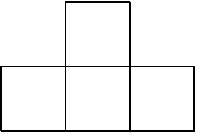Problems
Cut an arbitrary triangle into 3 parts and out of these pieces construct a rectangle.
Fill an ordinary chessboard \(8\times 8\) with the tiles shown in the figure.

From the set of numbers 1 to \(2n\), \(n + 1\) numbers are chosen. Prove that among the chosen numbers there are two, one of which is divisible by another.
a) In Wonderland, there are three cities \(A\), \(B\) and \(C\). 6 roads lead from city \(A\) to city \(B\), and 4 roads lead from city \(B\) to city \(C\). How many ways can you travel from \(A\) to \(C\)?
b) In Wonderland, another city \(D\) was built as well as several new roads – two from \(A\) to \(D\) and two from \(D\) to \(C\). In how many ways can you now get from city \(A\) to city \(C\)?
How many distinct seven-digit numbers exist? It is assumed that the first digit cannot be zero.
A car registration number consists of three letters of the Russian alphabet (that is, 30 letters are used) and three digits: first we have a letter, then three digits followed by two more letters. How many different car registration numbers are there?
How many are there six-digit numbers that are divisible by \(5\)?
We call a natural number “fancy”, if it is made up only of odd digits. How many four-digit “fancy” numbers are there?
A sack contains 70 marbles, 20 red, 20 blue, 20 yellow, and the rest black or white. What is the smallest number of marbles that need to be removed from the sack, without looking, in order for there to be no less than 10 marbles of the same colour among the removed marbles.
Some points from a finite set are connected by line segments. Prove that two points can be found which have the same number of line segments connected to them.